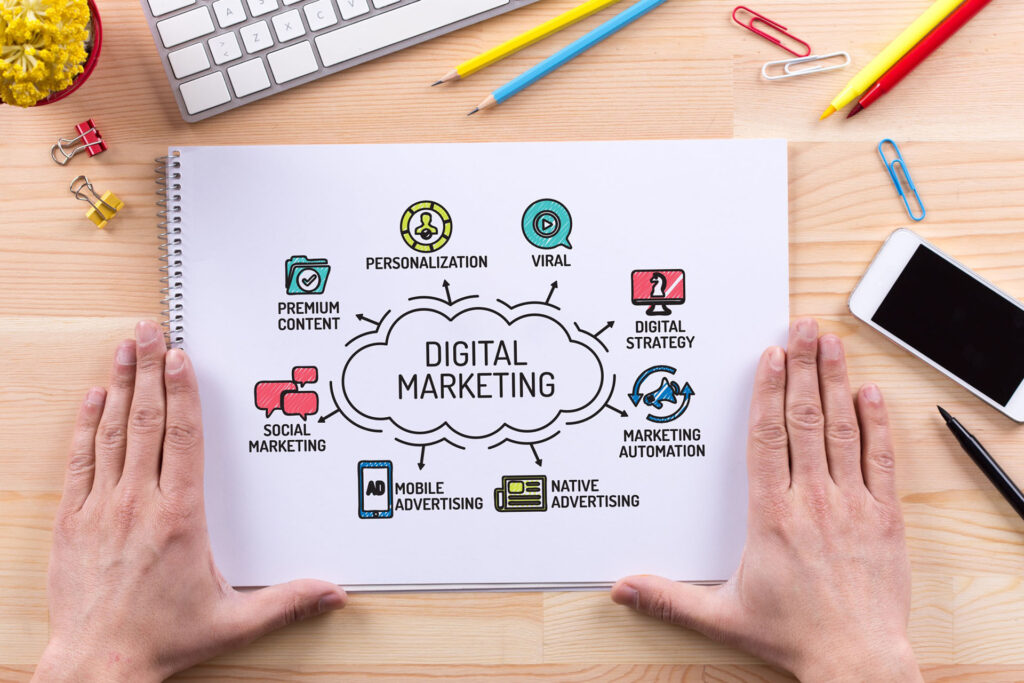The healthcare industry is rapidly evolving, and healthcare digital marketing has become a critical component of success. Healthcare providers, facilities, and professionals are recognizing the need to embrace digital strategies to connect with patients, enhance their online presence, and stay competitive. We will explore effective strategies for success in healthcare digital marketing, covering key topics, trends, and the role of digital marketing agencies.
The Importance of Healthcare Digital Marketing
In a world where people turn to the internet for healthcare information and services, digital marketing in healthcare is no longer an option; it’s a necessity. Here’s why:
Patient Empowerment
With the help of modern technology, patients are more informed and empowered than ever before, thanks to the wealth of healthcare information available online. The internet acts as an open library of medical knowledge, where patients can access information about symptoms, treatments, and healthcare providers at their fingertips. To effectively reach and engage these knowledgeable and discerning patients, healthcare providers must establish a strong and authoritative digital presence.
The modern patient desires more than just medical services; they seek guidance, trust, and transparency. They want to partner with healthcare providers who not only offer quality care but also provide a wealth of educational resources online. By embracing healthcare digital marketing, providers can meet this demand for information, empowering patients to make well-informed decisions about their health.
Visibility and Credibility
In the vast digital landscape, visibility and credibility are paramount for healthcare providers. Patients often turn to online reviews and websites to evaluate healthcare options. A well-executed digital marketing strategy can significantly enhance a healthcare provider’s online visibility, making them more accessible to patients searching for healthcare solutions.
A strong digital presence, characterized by a well-designed website, informative content, and engaging social media profiles, contributes to building credibility. Patients are more likely to trust healthcare providers who maintain an active online presence and demonstrate their commitment to patient education and transparency. By investing in healthcare digital marketing, providers can build trust with potential patients and foster long-lasting relationships.
Cost-Effective Marketing
Traditional advertising methods can be costly and often lack precision in targeting the right audience. In contrast, digital marketing offers highly cost-effective solutions for healthcare providers. It allows for precise audience targeting, reducing wasteful spending and maximizing return on investment (ROI).
Digital marketing tools such as pay-per-click (PPC) advertising and social media advertising enable providers to reach specific demographics, geographic locations, and individuals actively searching for healthcare services. This level of precision ensures that marketing budgets are efficiently allocated to reach those most likely to benefit from the services offered. Consequently, healthcare providers can achieve their marketing goals while maintaining financial prudence, making digital marketing a cost-effective strategy for growth.

Crafting an Effective Healthcare Digital Marketing Strategy
1. Understand Your Audience
Begin by thoroughly understanding your target audience. Identify their demographics, pain points, interests, and online behavior. This insight will help tailor your messaging and strategies for maximum impact.
2. Leverage SEO and Content Marketing
Search engine optimization (SEO) is at the heart of successful digital marketing in healthcare. Conduct keyword research to identify healthcare-related terms and phrases that resonate with your audience. Create high-quality, informative content around these keywords to drive organic traffic to your website.
3. Embrace Social Media
Social media platforms are fertile ground for healthcare digital marketing. Establish a strong presence on platforms such as Facebook, Twitter, LinkedIn, and Instagram. Share relevant healthcare updates and educational content, and engage with your audience to build trust.
4. Email Marketing and Patient Engagement
Email marketing remains a powerful tool for patient engagement. Implement personalized email campaigns that offer value to patients, such as appointment reminders, health tips, and newsletters. Segment your email list for targeted messaging.
5. Invest in Paid Advertising
Consider pay-per-click (PPC) advertising to target specific healthcare keywords and reach patients actively searching for services. Partner with a local digital marketing agency to ensure compliance with healthcare regulations.
The Role of Digital Marketing Agencies
Digital marketing agencies play a pivotal role in helping healthcare organizations navigate the complexities of digital marketing. Digital marketing agencies offer:
- Expertise: The expertise offered by digital marketing agencies extends beyond basic marketing knowledge. These agencies employ seasoned professionals who possess a deep understanding of the intricacies of the healthcare industry. They also do thorough research and are well-versed in healthcare regulations.
- Strategic Guidance: Effective digital marketing is not a one-size-fits-all approach. Healthcare providers have unique objectives, target audiences, and competitive landscapes. These agencies recognize this and offer strategic guidance that is tailored to the individual needs of their clients in the healthcare field.
- Technology and Tools: Digital marketing agencies are equipped with the latest technology and tools that help them to measure and optimize campaigns effectively. These tools go beyond basic website analytics and encompass comprehensive marketing automation platforms, keyword research tools, and sophisticated data analytics systems.
- Compliance: In the healthcare industry, compliance is not just a checkbox; it’s an ethical and legal imperative. A professional agency will help prioritize compliance with healthcare regulations and patient privacy standards in all their endeavors.

Healthcare Digital Marketing Trends
Staying ahead in healthcare digital marketing requires keeping an eye on emerging trends. These trends shape the landscape, influencing how healthcare providers connect with patients, share information, and deliver services. Let’s delve deeper into some of the most impactful trends reshaping the healthcare content marketing landscape:
Telehealth Promotion
The growth of telehealth has led to an unprecedented transformation in the healthcare industry. The COVID-19 pandemic accelerated the adoption of telemedicine, making it a vital part of healthcare delivery. As a result, there is now an increased emphasis on promoting telemedicine services online.
Telehealth promotion encompasses various strategies, from optimizing websites highlighting telehealth offerings to creating targeted digital advertising campaigns. Healthcare organizations are investing in user-friendly telehealth platforms and ensuring they have a prominent online presence to attract and educate patients about the benefits of virtual care.
Video Marketing
Video marketing has emerged as a powerful tool for healthcare digital marketing. Patients are increasingly turning to video content for education, information, and engagement. Whether it’s live streaming of medical procedures, educational videos about health conditions and treatments, or patient testimonials, video content is becoming a preferred medium for engaging patients.
Healthcare organizations are leveraging video marketing to provide a visual and personal connection with their audience. They are creating informative and emotionally compelling video content that not only educates but also builds trust. Live Q&A sessions with healthcare experts and virtual tours of facilities are just a couple of examples of how video marketing is being used to connect with patients on a deeper level.
Chatbots and AI
The integration of chatbots and artificial intelligence (AI) is revolutionizing patient interactions and streamlining processes in healthcare digital marketing. Chatbots are now used on websites and messaging platforms to offer immediate responses to patient inquiries, schedule appointments, and provide basic medical information.
AI-driven solutions are also enhancing patient engagement by analyzing data to offer personalized recommendations and reminders. Additionally, AI assists healthcare providers in analyzing vast datasets for research, diagnostics, and treatment plans. As technology continues to advance, chatbots and AI will play an increasingly prominent role in healthcare digital marketing, improving patient experiences and operational efficiency.
Voice Search Optimization
With the rise of voice-activated devices like smartphones, smart speakers, and virtual assistants, optimizing content for voice search is becoming essential. Patients are using voice commands to search for healthcare information, find providers, and schedule appointments. Therefore, healthcare organizations must adapt their digital marketing efforts to accommodate this trend.
Voice search optimization involves understanding how people speak naturally and crafting content that answers conversational queries. This includes creating FAQ sections on websites, using structured data markup, and optimizing for local SEO, as many voice searches are location-based. Staying ahead in healthcare digital marketing means embracing voice search to ensure your organization remains discoverable and accessible to patients using voice-enabled devices.
Personalization
Tailoring digital marketing efforts for a personalized patient experience is a growing trend in healthcare. Patients expect personalized recommendations and content that cater to their specific needs and preferences. Personalization can include customizing email campaigns, offering targeted health advice based on patient data, and providing individualized treatment options.
Healthcare organizations are harnessing the power of data analytics and machine learning to deliver personalized content and experiences. By analyzing patient data and behavior, organizations can offer relevant information, services, and treatment plans, ultimately improving patient satisfaction and engagement. Personalization not only strengthens patient-provider relationships but also enhances the effectiveness of digital marketing efforts.

Results-Driven Digital Marketing Strategy for Healthcare
Success hinges on understanding your audience, crafting a comprehensive strategy, and staying attuned to industry trends in healthcare. Leveraging the expertise of digital marketing agencies can provide a significant advantage in navigating the complexities of the healthcare industry while achieving your digital marketing objectives. Embrace the digital era of healthcare and position your organization for long-term success.
Check out our BrandRep blog today to learn more about our successful SEO, social media, and digital marketing strategies.
























